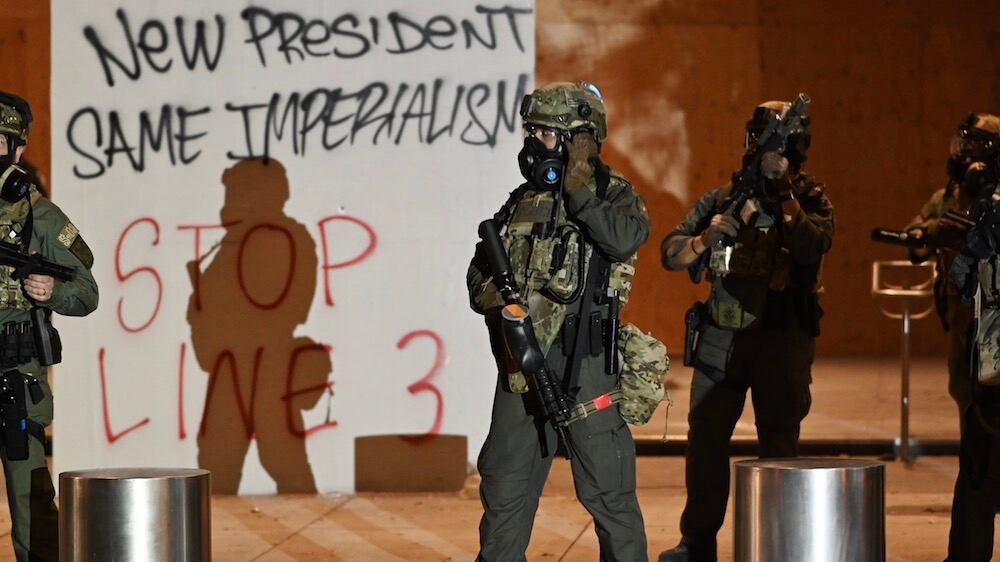The removal this week of a 10-foot-high fence surrounding the Mark O. Hatfield U.S, Courthouse was, in some ways, an optimistic gesture. It signaled that federal law enforcement, under a new president, no longer saw Portland demonstrators as a threat to resuming conventional routines.
Wrong.
Seven hours after the last pieces of the fence came down, an enraged crowd of activists resumed defacing the building. And for much of the weekend, federal and city police have resorted to notorious crowd-control tactics to quell renewed protest: tear gas from the feds, and mass detainment in the street by Portland police.
The latter approach did what little else has managed this winter: It stopped a protest and property damage for the night on Friday. It also received quick condemnation from advocates, including the American Civil Liberties Union of Oregon. The Portland Police Bureau's use of the tactic, called "kettling," opens a new chapter in the debate over dissent and unrest in Portland.
Following the 2020 summer of nearly continuous Portland-area protest, a lull during the colder months caused many to wonder if the marches, property destruction, and confrontations between local activists—at times rioters—and police squads would gradually come to an end.
But memories of a violent summer have not faded in activist circles: They can still draw small but fierce crowds of regular demonstrators intent on pressuring city government toward defunding the police. Over the winter, their most aggressive approaches to applying this pressure took the form of showing up at the homes of the mayor and city commissioners and, most commonly, smashing the windows of businesses they viewed as the antithesis of their anti-capitalist beliefs.

On Thursday night, the crowd that assembled in front of the federal courthouse had a strong vibe of provocation: looking to resume hostilities with the federal officers inside. Participants said the gathering was a continuation of a daytime march to call attention to the proposed Enbridge Line 3 crude oil pipeline expansion through Minnesota and territories of the Anishinaabe tribes.
The group had marched to the lobbies of Chase Bank and Wells Fargo to pray, demonstrate and otherwise put pressure on businesses they accused of funding Line 3. They shattered a window of the federal courthouse and vowed to return at night.
Contractors covered the damage with plywood in the interim hours, but not all the courthouse's windows. The crowd that assembled that evening covered the building's portico walls and concrete columns with graffiti, shattered an uncovered pane, and set the protective wood ablaze.
"There's a lot going on right now," a tall activist said into his phone, in the exhausted tone of someone in a couple's fight, as two-story flames crawled up the recently applied plywood behind him. "I can't talk to you right now. I need to go."
In addition to standing in solidarity against the Line 3 pipeline, some on the ground said they were there to oppose a "return to normalcy," which the dismantling of the fence represented.
Fencing and barriers had been in place since July, defending the courthouse against ongoing protests of police brutality, which at times drew crowds of thousands—especially following Trump's June 2020 order sending federal police forces to protect federal property from the nationwide protests.
In a far cry from the massive crowds of the summer, the impromptu action Thursday night started out with around a hundred people. Federal agents defended the building. In the process they made several arrests, and pressed the crowd out of the area with flash bangs, less lethal munitions, tear gas, and hexachloroethane gas.
An activist held a small portable boombox overhead and played "I Can't Breathe" by H.E.R. to an eerily quiet standoff between the remaining protesters and the federal police line. The moment called back to the actions of a protester named Donavan La Bella, whom federal agents wounded over the summer when they shot him in the forehead with a munition as he stood on the opposite sidewalk holding a boombox. The summer protests were long gone, but for the people who participated in them, a deep animosity simmered toward the agents and their willingness to inflict physical harm in defense of a building.
"See my face?" a protester shouted at the line. "Don't forget it! You're gonna see it all summer!"
"A hundred more nights!" the crowd chanted in support.
The next night, they tried to make good on their promise.

On Friday, March 12, even more people in identity-disguising clothing gathered—this time in the Pearl District's Jamison Square. The assembly carried a palpable undercurrent of rage.
Several on the ground gave the pipeline expansion as their reason for marching, but also noted that the threat to Indigenous lands was merely one more form of government oppression on a laundry list of injustices. Others mentioned the trial of Derrick Chauvin in Minneapolis—the police officer who kneeled on George Floyd's neck for eight minutes and 48 seconds, resulting in his death—and their low expectations for a conviction.
Residents of the Pearl taunted the marchers with homemade signs, encouraging them to use their stimulus checks to repair the windows they'd broken.
Another resident expressed worry over what the march would lead to, but as nearly 200 people crowded into the streets, he turned and said: "When I see this on TV, it's so scary, but here in the street I'm not feeling that way."
"Hey! You dropped something!" a marcher pointed to the sidewalk. The resident had dropped a can of pepper spray. They both fumbled to pick it up: a scene of typical Portland helpfulness.
But at the same moment, masked participants on the periphery of the crowd struck storefront and apartment windows, breaking them.
Almost immediately Portland police began to close on the crowd, tailing them on bicycles. They rode slowly but closely behind the group, twisting through the neighborhood streets. Then, with another force of officers, Portland police kettled the marchers on a one-block stretch of Northwest Marshall Street, blocking their ability to exit.
Via their loudspeaker truck, they announced they were detaining the group while they investigated a crime and advised the hundred or so caught between police lines to sit down in the street and await further instructions.
Soon after that, police announced that press and legal observers would be allowed to leave, if they provided credentials. As the evening wore on, police began entering the kettle in squads of four to five officers and escorting out one person at a time.
One such person was journalist Maranie Staab, who was forcefully escorted from the area, despite her insistence that she should be allowed to stay and film the scene. Portland police wrote Staab's name and birthdate on a piece of duct tape and affixed it to her chest. They asked that she remove her mask to be photographed and Staab declined.
"When I attempted to prevent them from taking my photograph, several pulled out their cellphones and started snapping away," Staab says. "They then laughed, high-fived each other, and escorted me further away from the scene."
One by one, Portland police plucked people from the block and cataloged their identities. Those who refused to identify themselves were arrested.
Detaining people in the street, or kettling, was challenged in several lawsuits last year by protesters. Judges dismissed the suits in January—allowing the city to return to the tactic just as Mayor Ted Wheeler was looking for answers to repeated vandalism.
In January, Wheeler described a desire to "gather intelligence on these small groups of organized criminals." Detaining and cataloging people immediately after property damage may be how police plan to do that.
Police charged 13 people with crimes ranging from disorderly conduct to unlawful possession of a firearm.
Now one question is whether the swift halting of vandalism at the beginning of the night will prove popular with most of the city's residents.
On this night, it was difficult to gauge. As the remaining marchers inside the kettle linked arms and legs in an attempt to passively resist arrest, people who hadn't been at the march gathered outside. Some of them clapped for the officers. But the louder voices were those beating drums and demanding, "Let them go!"

